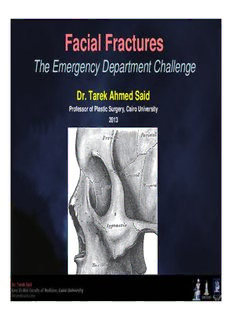
Facial Fractures; The Emergency Department Challenge - Angelfire PDF
Preview Facial Fractures; The Emergency Department Challenge - Angelfire
Facial Fractures The Emergency Department Challenge Dr. Tarek Ahmed Said Professor of Plastic Surgery, Cairo University 2013 Image from http://face-and-emotion.com/dataface/physiognomy/cranium.jsp Fracture Patterns • Nasal • Lateral Blow • Other • Zygomatic • Maxilla • LeFort I • LeFort II • LeFort III • Blowout Fractures • Frontal Sinus & Naso-ethmoid • Mandibular The Zygomas • Form the “cheekbones” • Articulate with the temporal, frontal, and maxillary bones • Their prominent position and shape renders them susceptible to injury Zygomatic Fractures • Cause: Blunt Force • Signs & Symptoms: – Pain – Numbness of the cheek, infraorbital region & upper teeth on injured side – Eyelid swelling – Inability to close mouth properly – Swelling, Edema, Ecchymoses – Flattened cheekbone – Palpable depression at fracture site • Treatment: Reduction & fixation The Maxillae • Form the upper jawbone • Contains the maxillary sinuses • Forms the inferior floor of the orbits • Contains a foramen to allow passage of the maxillary/infraorbital nerve Maxillary Fractures • Complex, Bilateral fracture that have an unstable “floating” fragment. • Classified based on the plane of the fracture. • LeFort I – Transmaxillary • LeFort II – Pyramidal/Subzygomatic • LeFort III – Craniofacial LeFort I : Transmaxillary • The fracture occurs along the nasal and maxillary floor • Almost always involves the pterygoid process of the sphenoid bone • May involve the maxillary sinuses • The resultant “floating” component is the lower part of the maxilla and its teeth LeFort II : Pyramidal/Subzygomatic • Result from a downward force on the nose • Fracture runs from the peak of the nasal bone laterally beneath the . orbits LeFort III : Craniofacial • Most severe • Often associated with extensive soft tissue injury • Large force is necessary to cause this type of fracture • The resultant “floating” component is virtually the entire face
Description: